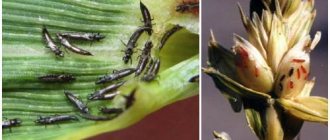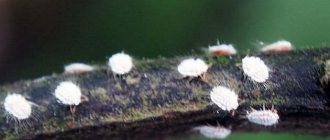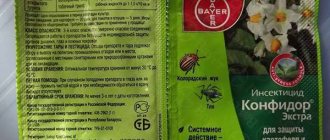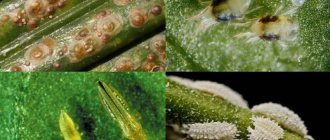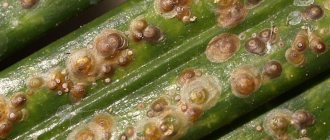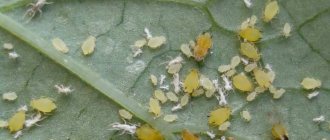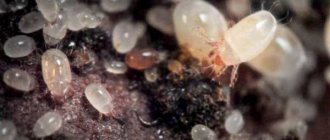home/
Garden pests
/
Mealybug: how to get rid of a pest of indoor plants?
- Mealybug: how to identify the pest? External characteristics of mealybug
- Mealybug lifestyle
- Comfortable living conditions for mealybugs
- Grape mealybug
- Insecticidal methods of controlling mealybugs
Mealybugs (Pseudococcidae) belong to the hemiptera family. This family includes several thousand species; about 330 species are common in Europe. Mealybugs are also called “false lice,” “felt lice,” and “hair lice.”
Most mealybugs have a similar appearance and lifestyle. This insect is often confused with the scale insect, which is its close relative. The pest is also known for being extremely picky about food.
Who are worms?
The scale insect is a pest that feeds on plant sap and is a relative of scale insects. Insects are covered with a protective waxy coating and villi (clearly visible in the photo), which makes it difficult to control them.
Body length ranges from 3 to 12 mm, depending on the species. Males are much smaller than females, have wings, and resemble small white midges. Due to the lack of oral apparatus, they do not need food, and their lifespan is not long.
Females usually live in colonies, on different parts of the plant; They are characterized by an asexual method of reproduction - parthenogenesis.
The most common types of mealybug
Accurate species identification allows you to find out which plants are particularly at risk due to arthropod attack. Although all mealybugs have similar external characteristics, each has slight differences.
Let's look at the most common types of mealybug.
Grape mealybug
The grape mealybug (Planococcus citri) is found both indoors and outdoors. Most often, this pest can be seen in Georgia, Southern and Central Europe, southern Russia, Armenia, Azerbaijan, southern Ukraine, Tajikistan, Turkmenistan and Uzbekistan.
The insect has a loose coating, through which you can see the pinkish or greenish body of the insect. Has 18 pairs of thin wax threads. Most often it settles on any citrus fruits, figs, grapes. The vine mealybug also prefers coffee tree, jasmine, amaryllis, gardenia, aralia, ivy and ferns.
Apple mealybug
The body length of the pest reaches 5 mm, the body is oval, pink and covered with a white powdery coating. This species is found in the Volga region, Leningrad region, Guryev region of Kazakhstan, the CIS, Transcaucasia and Ukraine. It stands out with its bright segmentation. In one year, the female lays only one clutch of eggs. The offspring overwinters in cracks, under stones, bark or leaves.
Most often, the apple mealybug (Phenacoccus mespili) feeds on the sap of apple, plum, pear, apricot, medlar, and ash trees.
Primorye mealybug
The seaside mealybug (Pseudococcus viburni, formerly known as Pseudococcus affinis) is the most common. An adult female reaches a size of 3-4 mm and has a pinkish-gray color. The insect has developed legs. The seaside mealybug reproduces by eggs.
The seaside mealybug prefers cacti, succulents, asparagus, camellia, dieffenbachia, pelargonium, laurel, oleander, cypress, rhododendron, cordyline, coleus, crinum and citrus fruits.
Quince sunbug
Distributed in Russia, Transcaucasia, and Ukraine. Usually lives on wild plants, but can also settle on roses, rose hips, and quince.
Bristle Mealybug
The bristly mealybug (Pseudococcus longispinus) is widespread and adapts extremely easily to changes in environmental conditions. The female of this species reaches 3.5 mm in length and is pale pink or orange in color. Females do not lay eggs; they are viviparous. Pests have well-developed limbs, so they can easily move from one plant to another.
Most often, the bristly mealybug hides on the undersides of leaves, in the axils and on the tops of young shoots. Sometimes insects settle on the bulbs.
The insect attacks tropical and subtropical plants and citrus fruits: persimmon, grapes, magnolia, begonia, lemon, dracaena, clivia, coleus, pandanus, cycad, ficus, fuchsia, asparagus, dieffenbachia, oleander, primrose and palm.
Bristle mealybug, photo
Primorsky mealybug, photo
Grape bug (citrus bug), photo
Juniper mealybug
Females of this species reach 3 mm in length, they are oval in shape and brown in color. Like other species, they are covered with a white waxy coating.
The juniper mealybug is common in Russia, namely in the Northern, Northwestern and Central regions, as well as in some areas of the Far Eastern region. The pest is often found in Ukraine. This type of mealyworm poses a serious threat to cypress and juniper trees. The larvae can overwinter in needles or bark.
Wheat stem worm
This arthropod can be found in Southern Europe, the southern European part of Russia, and also in Ukraine. The insect always settles under the vaginal leaves of wheat.
Barley stem worm
The species can be seen in Southern and Central Europe, Moldova, European Russia, Western Kazakhstan and Ukraine. The barley variety is completely similar to the wheat variety, but most often damages wild cereals and sometimes harms barley. For this reason, the barley stem bug is considered less dangerous.
Maple mealybug
The pest is distributed in Moldova, Transcaucasia, Southern and Central Europe, Kazakhstan, the European part of Russia, Primorye, Sakhalin, the Kuril Islands and Ukraine.
Maple mealybugs are distinguished by their high fertility. They usually feed on the sap of oak, apple, alder, ash, currant, and maple trees. The insect can also pose a threat to linden, rowan, gooseberry, hawthorn, hornbeam, and horse chestnut.
Alfalfa mealybugs
The main places of residence are Southern and Central Europe, the south of the European part of Russia, Transcaucasia, Kazakhstan, Ukraine, Central Asia.
Most often, this species parasitizes wild plants, alfalfa. It can be seen less often on other garden crops. The alfalfa bug is considered one of the most picky eaters, which increases its survival rate and complicates pest control.
Spruce mealybug
It lives in Ukraine (Polesie and Transcarpathia) and in the Northwestern regions of Europe. It feeds exclusively on spruce sap. It poses a huge threat to trees, as it significantly increases the rate of death of needles. Large colonies quickly destroy the plant, simultaneously hiding in the bark or needles.
Palm mealybug
This species is quite rare. It is a dangerous quarantine pest. The body of the female reaches 2.5 mm in length, it is cream-colored and covered with a waxy coating in the form of cone-shaped spines.
The palm mealybug damages palm trees, avocados, orchids, bananas, aroids and other subtropical plants.
The species presented above pose the main danger to plantings. The mealybug is capable of destroying a huge number of plants, so it is one of the main enemies of nurseries.
How do worms harm plants?
Insects cause great harm, leading pets to death. They prefer plants with large leaves, such as palm trees, ficus, orchids, laurel, and ferns. They settle on the reverse side of the leaf, in the area of large veins and stems.
- Mealybugs on indoor flowers suck out the juice, weakening them. Some species attack the roots.
- During their life, they secrete a sweet, sticky secretion that attracts ants and also contributes to sooty fungus and mold.
- Saliva contains phytotoxic enzymes that cause plant poisoning.
Mealybug: what is it and what does it look like?
Mealybug is an insect pest that settles on plants and sucks the juices out of them. Because of this, the growth and development of the flower slows down. Moreover, the mealybug can settle in any flowerpot, from cacti to azaleas or orchids.
Outwardly, it is a nimble small bug, covered with a whitish coating. Most often they gather in groups near young shoots, buds or on the underside of leaves. Some species can even affect the root system of a plant.
Small larvae actively move along the stems until they find somewhere to attach themselves. Adult insects reach several millimeters in size and actively reproduce. Most often, the worm comes from neighboring affected plants, for example, in a flower shop. But sometimes larvae can even be carried by the wind.
Fortunately, mealybugs are generally easy to spot and identify. The white coating clearly appears against the green background. Therefore, we recommend periodically carefully inspecting all flowerpots. The next stages of infection are sticky sugary discharge and sooty fungus.
Photo: gardenmanage.com
Pests of indoor plants: names, photos and how to deal with them
Developmental cycle of mealybugs
- Egg. Females lay eggs in a felt cocoon. Some species are viviparous - producing live larvae.
- The larvae move quickly, conquering new spaces; they are called “vagrants”. In some species, they are inactive. There is no gender distribution.
- Imago. After molting, strays become adults, females and males.
Mealybug - this malicious pest of flowers
He “loves” to settle on palm trees, crotons (codiaum), ficus, orchids, ivy of all kinds, and violets. These pests affect all citrus plants, amaryllis, azaleas, asparagus, cacti, grapes, camellia, gerbera, oleander and many other indoor plants, especially on young leaves and twigs, larvae and young individuals of the pest often live. for example: often the mealybug infects the young leaves of dracaena lemons, indoor tangerines (calamondins), crassula, date palms, fuchsias - their tender young shoots are quickly sucked out by adult mealybugs and their larvae and the leaves wrinkle, begin to dry out and fall off.
Mealybug individuals also settle on the fruits and ovaries of plants, significantly slowing down their development, which in turn leads to the falling of flowers, fruits and buds.
Signs of insect damage to indoor plants
At the initial stage of the disease, insects are difficult to detect, as they hide in the axils of the leaves.
Felt coating
A white coating appears on the stems and leaves of flowers, resembling cotton wool sprinkled with flour. These are cobwebs and wax dust secreted by females.
Sticky leaves
In the process of life, a sweet secret is released - honeydew, which is attractive to ants and moldy fungi. Leaves sticky marks on the pot, windowsill, window glass.
White lumps on roots
This sign can only be detected during transplantation. White lumps will be visible among the roots and soil. They can be confused with root aphids.
drooping look
A drooping appearance of the plant may be the only symptom of rootworm infestation.
General information about the pest
Important details:
- tiny orthoptera insect, suborder coccidae. The mealybug is a close relative of another pest, the scale insect;
- body length – from 3 to 5–6 mm;
- characteristic external feature is a powdery coating, color is cloudy white;
- the parasite has a long proboscis for actively sucking juices from indoor plants;
- when pests actively multiply on leaves, buds, in the root zone, roots and stems, areas resembling lumps of dirty cotton wool appear;
- the pest actively reproduces not only on indoor flowers, but also in closed ground conditions (greenhouses);
- adult individuals move slowly, young scale insects actively move around the flower in search of succulent shoots and tender buds;
- The parasite multiplies quickly at temperatures above + 25 degrees.
Many amateur flower growers note: the dangerous parasite quickly adapts to any conditions except low temperatures. It is believed that the insect is afraid of moisture, but often even washing the leaves and other parts of the plant does not affect the life activity of the mealybug. A hot “bath”, soaking in Actellik solution, removing pests with cotton swabs often gives only a temporary effect: there is a high probability of parasites reappearing. If you do not use powerful insecticides, then another pest may settle on the plant - spider mites, which are as difficult to fight as scale insects.
Find out how to quickly clean the inside of your microwave to remove grease and dirt.
Read about how to care for cyclamen at home and how to water the plant in this article.
How to deal with mealybugs
Treatment must be carried out comprehensively, using several methods. Good results are obtained with chemicals in combination with a mechanical method of removing insects.
Mechanical method
With this method, pests are removed by mechanical means:
- Cutting out severely affected leaves and branches.
- Wash off insects with soapy water, using a sponge or soft brush.
- Nearby surfaces should be thoroughly washed: window sills, shelves, window frames, flowerpots - they can be a source of microscopic larvae.
Chemical
Insecticides that have an intestinal and systemic mode of action are used against mealybugs. Due to the fact that insects are covered with a protective waxy coating, contact exposure has no effect.
Due to toxicity, it is advisable to use chemicals in cases of extreme necessity, if home remedies are problematic to use or do not help.
- "Aktara" has an intestinal-contact, systemic spectrum of action. It affects the pest by direct contact with it, with simultaneous penetration inside through the oral apparatus. When applied to the soil, it is well absorbed by the roots, making plant juices toxic to parasites.
- "Aktelik" has a wide spectrum of action, systemic and contact. Treatment is carried out by spraying.
- “Bi-58 new”, systemic-contact mode of action. Affects any stage of insect development. The substance is quickly absorbed by the plant, the death of pests occurs within 24 hours. Highly effective against insects that parasitize roots.
- “Golden Spark” – works systemically, has a long-lasting effect, up to 2 months.
Important: treatment with pesticides is carried out using personal protective equipment.
Biological insecticides
Biological preparations such as Fitoverm do not have a systemic effect, therefore they are not effective against scale insects.
Ways to combat insects without “chemistry”
You can try to deal with mealybugs without resorting to chemicals, especially if there are not too many insects. Amateur gardeners have tested many folk remedies for mealybugs, and some have shown high effectiveness.
Stages of work:
- First, the plant is isolated.
- Cut off the affected shoots and leaves, buds and flowers, ovaries and fruits.
- Using tweezers, a damp swab or a cotton swab (a toothpick or a match with cotton wool wound around it), remove lumps of fluff and insects from the stems and large leaves, penetrating into the leaf axils and folds, not forgetting to look under the leaves.
- All affected areas should be wiped with alcohol or a pharmaceutical alcohol tincture of calendula (vodka is not suitable due to the low concentration of alcohol). This will help remove the smallest wandering larvae, as well as sticky plaque.
- The bottom of the pot and under the rim should also be treated.
- The pseudobulbs of orchids are wiped with alcohol, having previously cleared them of dry scales.
- After these procedures, it is recommended to treat the plants three times at weekly intervals. For this, special solutions are prepared, choosing one of the convenient options; They are applied to plants by spraying or brushing. When spraying, cover the soil in the pot from getting the drug.
Folk remedies (optional):
- Lemon and/or orange peels - daily infusion of 50 g per liter of boiling water.
- Garlic (cloves) – chop 8 cloves, pour in a liter of boiling water, leave for 4-6 hours, strain.
- Tobacco decoction: 100 g is boiled in a liter of water for half an hour, after a day it is filtered and diluted 2-3 times with water. The product is poisonous and must be handled very carefully!
- Pharmaceutical oil extract of horsetail. An infusion of dry horsetail herb is also prepared: 100 g per liter of boiling water.
- Olive oil – 1 tbsp. l. for half a liter of water. The oil film interferes with the breathing of pests.
- Soap solution: 1 tsp. crushed laundry soap per 1 liter of water. You can use store-bought insecticide Green soap (1 tbsp per 1 liter of water). It is recommended to add 2 tbsp to the solution. l. vodka. This remedy is used several times every 3 days.
- You can try to destroy the root bug with hot water. The roots are immersed for a quarter of an hour in a large container of water, the temperature of which is strictly +55 degrees.
After treatment, it is recommended to replant the plants. The pots are thoroughly washed with a strong soap solution, and the suspicious soil is fried in the oven.
How to get rid of mealybugs without using chemicals
Chemicals are far from safe, especially when used in an apartment. Immediately after detecting a pest, you can use folk remedies.
Green soap
Environmentally friendly product. Soap foam is applied to open, visible areas. After 2 – 3 hours, after treatment, it should be washed off.
Tobacco infusion
- Shag, raw materials or tobacco dust, in the amount of 80 grams, pour 1 liter of warm water, leave for a day.
- Then the resulting infusion is filtered and brought to its original volume.
- Treatment is carried out by spraying or washing.
What to do to prevent mealybugs from appearing on flowers
- Inspect plants carefully before purchasing.
- Even if the new flower seems healthy, give it a mandatory 2-3 week quarantine. Keep the plant separate from others.
- Inspect all green pets regularly, for example when watering. The sooner you notice the pest, the easier it is to deal with it.
- Spray the plants regularly and wash them in the shower once every month and a half. The exception is violets, geraniums and other indoor flowers with pubescent leaves.
Prevention measures
Mealybugs are quite difficult to exterminate, severely depleting plants. Therefore, it is much more effective to prevent their occurrence.
- Compliance with the rules of care is the most important preventive measure, since pests, as a rule, attack weakened plants.
- Regular examination of “pets” will help to recognize infection at an early stage.
- Before you bring a new plant into your home, you need to inspect it carefully.
- Quarantine for newly acquired pets is at least 30 days.
- Soil disinfection.
- Thorough disinfection of pots after diseased flowers.
In order to fight a pest, you should know its preferences and biological characteristics. Eliminating conditions favorable for parasites is the main task of preventing infection.
Mealybug - what are the treatment methods?
Mealybugs are very difficult to get rid of. After all, mealybug larvae live not only on leaves and stems, but even in the soil, on the roots of the plant. Therefore, even if you completely replace the soil, there is no guarantee that you will remove the pest from them. By the way, in the greenhouses of some European countries (Poland, Holland), greenhouses that grow and supply us with flowering plants - violets (Saintpaulias), fuchsias, begonias and other flowering and decorative foliage (begonias), when the planting material is severely damaged by mealybugs, prefer not to waste time and money to treat diseased plants (after all, the bug spreads quickly in greenhouses and easily adapts to various drugs!).
The affected plants are simply burned, the room is thoroughly disinfected with potent drugs and new planting material is grown, since there are no guarantees for treatment against mealyworms.
What kind of worm is there?
This is an insect with an oval body. It has bristles on the sides, and the whole body is covered with a white coating. Stripes are usually visible across the back, so the pest can be seen without special tools. The maximum size of the insect is 7 mm, the minimum is 3 mm.
When the mealybug sprays its sticky mucus, it appears as if the flower is covered in flour. Under it you can find a mealybug and the eggs it lays. The mealy consistency interferes with proper gas exchange.
Most often, the insect can be seen on young twigs and even flower buds. There are situations when they appear on windowsills or on the soil itself in a pot. In total, more than one and a half thousand varieties are known in the world, but the presence of bristly, grape, citrus and seaside scalebugs is very dangerous for indoor plants.
Among the plants on which the pest may appear are:
- Amaryllis;
- Cactus;
- Palm;
- Monstera;
- Kalanchoe;
- Hibiscus and others.
Description and life cycle of the pest
In nature, there are almost 1,600 varieties of mealybugs of the lamellar family. All these parasitic insects are found not only on ornamental crops, but also on fruit, industrial, and greenhouse crops; they attack them to the last, until they are completely dried out.
In size and lifestyle, mealybugs are very similar to aphids, their only difference is their appearance. A plant affected by this pest looks as if it has been floured due to the multitude of tiny white parasites that are tightly clinging to the trunk.
Mealybugs produce honeydew as a result of their life activity. This sugary sticky coating is the source of a dangerous disease; a sooty fungus settles on it, causing the death of the indoor plant in the absence of timely treatment.
It is quite easy to detect mealybugs on indoor plants, even with the naked eye. This pest belongs to the category of sucking insects. The size of its oval body is only 3-6 mm in length, almost like a tick, it all depends on the type of parasite.
The scale insect has a large number of legs and antennae, which are covered with a white waxy powdery coating with bristles on the sides. There are specimens of pink and cream color. Even among plant growing enthusiasts, the mealybug is called a hairy louse.
The source of nutrition not only for adults, but also for larvae, is the juice of young shoots, leaf blades, and buds. As a result, white sticky mucus forms on these vegetative organs of the indoor plant - a coating similar to cotton wool, which negatively affects the general condition of the flower - disturbances in the process of gas exchange are observed.
In addition, toxic substances from the pest enter the puncture area, disrupting the development of the green pet. A diseased plant stops growing, withers and ultimately dies. Considering the increased activity of these small white insects, in a short time they can quickly spread to neighboring flowers, and then they will have to be dealt with only with the help of chemicals.
For the most part, female mealybugs are viviparous, but there are some representatives that lay their offspring in a white facial sac, resembling cotton wool in appearance.
Vagrants - the larvae of the first instar are especially distinguished by their ability to move quickly; they easily fall from one plant to another as a result of a draft, as well as with the help of an animal or person. As soon as the larvae attach themselves to the green pet, they lose their mobility. The next generation, when the molting is over, again begins to search for food.
The mealybug has strong sexual dimorphism, with clear differences between males and females. Males have a distinct head, abdomen, and chest, and have highly developed wings and limbs. But the females, because their bodies are too elongated, look like larvae; it is almost impossible to see their sections.
It is surprising that males, unlike females, have a shorter life expectancy; this feature is explained by the fact that in adult life they do not eat anything. Due to the waxy coating, females are endowed with good protection against most chemicals. In addition, they have an excellent degree of adaptability to many intestinal insecticidal preparations.
The danger of the presence of mealybugs on indoor plants is that they begin to cause harm unnoticed, but very strongly. One part of the flower is the first to be affected, and then the entire green mass becomes infected.
The death of a green pet occurs as a result of its exhaustion; sucking parasites completely suck out the juice, which contains all the vital elements. Considering the seriousness of the situation - the high fertility of females, measures should be taken to destroy parasitic individuals as early as possible, then the chances of a quick restoration of the flower will be much greater.
In the early stages of infection, you can get by with folk recipes, and in advanced cases - only through the use of chemicals that are diluted in strict accordance with the manufacturer's instructions. If the green pet has suffered very badly, then both methods must be used.
Among the indoor plants that most often suffer from mealybug invasion, experienced gardeners identify:
- gerbera;
- amaryllis;
- cactus;
- oleander;
- representatives of citrus fruits;
- azalea;
- fuchsia;
- decorative palm tree;
- asparagus;
- camellias;
- anthurium;
- monstera;
- Kalanchoe;
- orchids;
- hoya;
- chlorophytum;
- Dieffenbachia.
How to get rid of it?
If you “caught” the disease at the initial stage, fighting it at home will not be difficult at all.
To do this, you simply need to treat the surface of the leaf plates and shoots with a soft sponge soaked in a concentrated solution of laundry soap, and clean off the bug, as well as its cotton wool-like traces, by hand. Then the green pet is treated with infusion of cyclamen, garlic or tobacco decoction. Treatment is carried out at least 3 times with a frequency of 7-10 days. Calendula infusion is also quite effective; you can use alcohol
We pay special attention to the fact that the alcohol must be undiluted - in this case, it quickly evaporates from the surface of the leaf and does not cause harm to green tissues. If it is diluted with water, it will linger on the leaves longer and during this time can cause significant damage to the flower.
Chemicals
It is advisable to treat the diseased flower with insecticides during the period when the larvae hatch and leave their egg sac - at this stage their body is not yet covered with a layer of wax, so they are most vulnerable. However, the main difficulty in the fight against scale insects is that at the same period there are several generations of insects on this plant at once, and a single application of poison will kill only the youngest individuals, and after a few days they will be replaced by new hatched larvae.
That is why any treatment must be carried out at least 3-4 times with an interval of 7-14 days. Keep in mind - the greater the stage of development of the parasite, the more difficult it will be to get rid of the scourge later. There are many methods of controlling insects; a wide variety of chemicals are presented on store shelves, which, depending on the characteristics of the effect on the pest, are divided into 3 categories:
- Systemic insecticides. They penetrate green tissues through the pores and make the juice of indoor plants poisonous. Particularly effective are formulations based on parathion and malathion - “Phosfamide” and “Rogor”.
- Intestinal compounds that have the ability to penetrate into the insect through the mouth. These include the insecticides "Aktara", "Aktellik", "Nurell-D", "Teppeki" and "Confidor".
- Contact drugs. They penetrate the integument of the parasite. Spruzit-A ESchadlingsfrei is considered the best; its main advantage is the absence of the need for multiple treatments.
Please note that when working with systemic insecticides, it is important to strictly follow the instructions for use of the product. Find out in advance from what distance the liquid should be sprayed to avoid causing harm to the leaves of the plant, and also check whether you need to use personal protective equipment
Folk remedies
There are many quite effective “grandmother’s” methods of combating parasitic scale insects. The most popular include the following.
- Horsetail tincture. This herb is sold in every pharmacy; it must be filled with pure alcohol, left for 3-5 days, strained and sprayed on the diseased plant with a spray bottle.
- Olive oil. 2 tbsp. l. The oils are dissolved in 1 liter of water, intensively mixed and the green parts of the plant are treated.
- A very effective product is obtained by mixing 15 g of green liquid soap, 10-15 g of denatured alcohol, and 1 liter of water.
- Many gardeners use a decoction of garlic. To do this, grind 4-6 cloves and pour in 0.5 liters of water, then bring to a boil and leave for at least 5 hours. The prepared decoction is filtered and applied to the leaf blades of the plant with a sponge.
Where do mealybugs on houseplants come from?
Mealybugs are very insidious. One day the plant is fine, but the next day it is covered in sticky white cotton wool. Where do they come from? Like any other pest, mealybugs can essentially come from anywhere. The most common reasons:
- introduced with a new plant;
- contaminated soil was used;
- indoor plants were placed outside in the summer;
- may even appear with fresh food or flowers from the store;
- ants sometimes bring mealybugs to indoor plants, they breed them like aphids, feeding on the remains of the honeydew produced by the insects.
Mealybug (Planococcus)
Treatment with folk remedies - effective methods
In the initial stages of mealybug infestation, you can use simple folk methods. They are significantly inferior to chemicals in terms of destruction efficiency, but they do not harm apartment residents and are well suited for housewives who prefer traditional home methods.
Soap solution
The most famous and effective method is using a soap solution. It is easy to prepare at home and does not require special materials that are difficult to obtain. You can get rid of the insect in several treatments.
Even dishwashing detergent will do, as long as it foams well. The more foam and thickness there is in the resulting consistency, the more successful the processing will be. It is necessary to wash not only the infected areas, but also healthy ones, as well as the pot and the place where the plant stood. This will reduce the chance of the parasite reappearing.
After treating all areas, the solution must be left for two to three hours so that it is absorbed. After this, rinse with water. The mixture will become concentrated if you add a few small spoons of ammonia. The effect will be stronger. After 15-20 minutes, rinse off.
This product is not suitable for all plants. Before using, you need to familiarize yourself with the characteristics of your homemade greens. Particularly delicate leaves can get burned. Therefore, look for useful information about the requirements of different cultures in advance.
Garlic tincture
There is another good method for killing mealybugs. All you need is a head of garlic. It has insect repellent properties. It's easy to prepare the product. The cloves must be crushed to a pulp to form one full teaspoon. Mix it with one glass of clean water and leave to infuse for several days in a sealed container. The resulting mass should be applied to the affected areas every week.
Solutions from onion peels and tobacco
A good option is a solution made from onion peels. Taking 20 grams of crushed husks, you need to mix it with 1 liter of warm water. Then leave to infuse for one day. The resulting product should be sprayed on the affected leaves. 2-3 procedures are enough for recovery.
Dry tobacco tincture
There is another type of prevention, more difficult to prepare, that successfully removes mealybugs. To do this, you need plain water and a strong infusion of dry tobacco. Eighty grams of shag should be poured with warm water and left to infuse for one day. After time, strain the mixture and then dilute with clean water. The product can be used both for spraying and for washing affected areas. It quickly removes white plaque and destroys insects.
Destruction with chemicals
If the stage of infection has reached its maximum, and folk remedies do not help, you can use chemicals aimed at prompt rehabilitation of plants.
There are many products designed to kill pests at lightning speed. The most common ones include:
- Aktara.
- Akarin.
- Actellik.
- Inta-Vir.
- Bankol.
- Karbofos.
- Vertimek.
- Confidor Extra.
- Tanrek.
- Fitoverm.
Each of them has its own characteristics and potency. They must be selected in accordance with the degree of damage to the plant and its individual characteristics. Price from 10 to 120 rubles.
If a crop is heavily damaged by pests and requires quick rehabilitation, the first step is to treat it with Aktara. The infusion is very powerful, quickly destroys insects and removes white plaque. It can be replaced by Inta-Vir or Confidor. Insecticides are safe for people, instantly kill the disease and are an excellent option for treatment.
Quite strong agents that can compare with them are Karbofos and Vertimek. But they lose because they are toxic to people. Treatment with drugs is carried out in the open air, in a place where a person cannot get poisoned. This will reduce the risk to people and animals.
If the plant is only slightly affected by pests, you can use Aktara or Fitoverm. Their advantage is absolute safety when used by people. The treatment is carried out both at home and in open areas.
Regardless of the drug you choose, you must carefully read the instructions and strictly adhere to all instructions. Each of them has its own individual approach, so pay attention to the correct application so as not to harm either yourself or the plant.
To enhance the effect, it is useful to cover the processed greens with a transparent bag and leave it there for a couple of hours so that it is well soaked. The resulting “greenhouse” must be removed from bright sun and hot places so that the plant feels comfortable and does not overheat.
Depending on the degree of infection, flowers must be treated correctly. It is necessary to provide for the number of subsequent treatments. Some products are effective after the first wash, others require several applications. In case of severe damage, it is advisable to carry out 3-4 sprayings.
The interval between each use of the product should be about a week. For best effect, treat affected areas at a temperature of +22-24°C. This is the period of the most active activity of parasites and is ideal for their destruction. If treatment is carried out at a cooler temperature, the drug may not be effective and will require increased repeated spraying.
